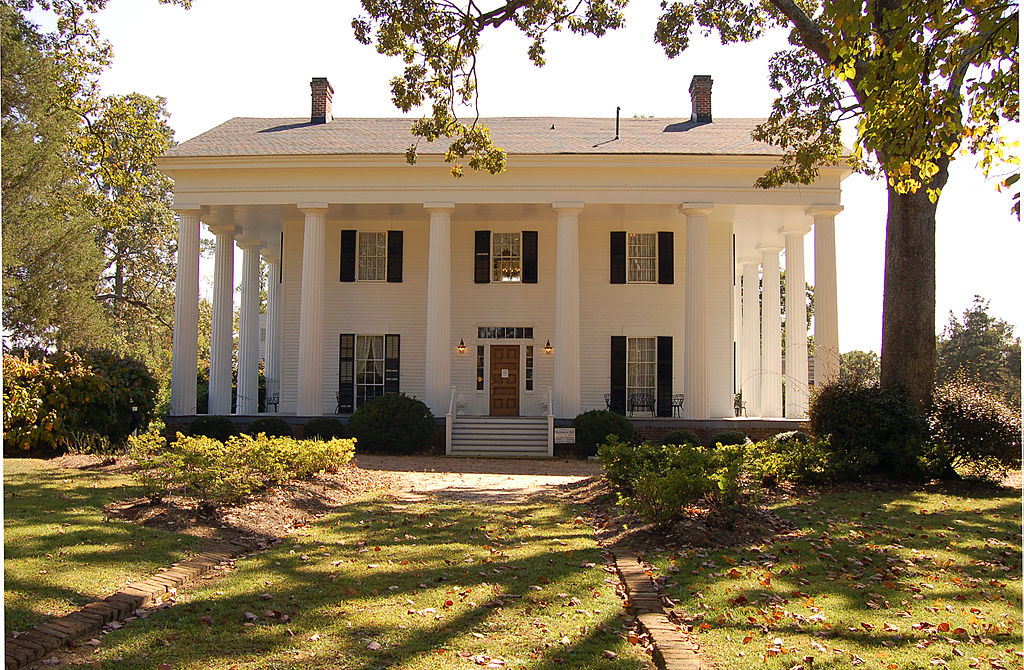Antebellum architecture refers to the large, elegant mansions—usually plantation homes—built in the American South during the 30 years or so before the American Civil War (1861-1865). Antebellum means "before war" in Latin.
Antebellum is not a particular house style. Rather, it is a time and place in history.
Antebellum Time and Place:
The features we associate with Antebellum architecture were introduced to the American South by Anglo-Americans, outliers who moved into the area after the 1803 Louisiana Purchase and during a wave of immigration from Europe. "Southern" architecture had been characterized by whoever lived on the land—the Spanish, the French, Creole, Native Americans—but this new wave of entrepreneurs began to dominate not only the economy, but also the architecture in the first half of the 19th century.
Great numbers of Europeans seeking economic opportunities emigrated to America after Napolean's defeat and the end of the War of 1812.

Barrington Hall is one classic example of an antebellum home.
Antebellum architecture (meaning "prewar", from the Latin ante, "before", and bellum, "war") is the neoclassical architectural style characteristic of the 19th-century Southern United States, especially the Deep South, from after the birth of the United States with the American Revolution, to the start of the American Civil War Antebellum architecture is especially characterized by Georgian Neo-classical, and Greek Revival style plantation homes and mansions.
Examples of Antebellum Architecture:
The term "Antebellum" stirs thoughts of Tara, the palatial plantation home featured in in the book and movie Gone with the Wind. From grand, pillared Greek Revival mansions to stately Federal style estates, America's antebellum era architecture reflects the power and idealism of wealthy landowners in the American South, prior to the Civil War. Here are a few examples of Antebellum homes:
- Oak Alley Plantation in Vacherie, Louisiana
- Belle Meade Plantation in Nashville, Tennessee
- Long Branch Estate in Millwood, Virginia
- Longwood estate in Natchez, Mississippi
This architecture of time and place has served its original purpose, and the question now for these buildings is, "What's next?" Many of these homes were ruined during the Civil War—and later by Hurricane Katrina. After the War, private schools often consumed the properties. Today, many are tourist destinations and some have become part of the hospitality industry. The question of preservation is every-present for this type of architecture. But, should this part of America's past be saved?
After Katrina: Lost Architecture in Mississippi
New Orleans was not the only area damaged by Hurricane Katrina in 2005. The storm may have made landfall in Louisiana, but its path ripped straight through the length of the state of Mississippi. "Millions of trees were uprooted, snapped or severely damaged," reported the National Weather Service from Jackson. "It was the fallen trees that caused just about all of the structural damage and downed power lines across this region. Hundreds of trees fell onto homes causing minor to major damage."
It's impossible to calculate the full extent of Hurricane Katrina's damages. In addition to the loss of lives, homes, and jobs, towns along America's Gulf Coast lost some of their most valuable cultural resources. As residents began to clean up the rubble, historians and museum curators began to catalog the destruction.
One example is Beauvoir, a raised cottage built shortly before the Civil War in 1851. It became the final home for Confederate leader Jefferson Davis. The porch and columns were destroyed by Hurricane Katrina, but the Presidential archives remained safe on the second floor. Other buildings in Mississippi were not so lucky, including these destroyed by the hurricane:
The Robinson-Maloney-Dantzler House (view photo)
Built in Biloxi c. 1849 by English immigrant J.G. Robinson, a wealthy cotton planter, this elegant, columned home had just been refurbished and was about to open as a Mardi Gras Museum.
Built in Biloxi c. 1849 by English immigrant J.G. Robinson, a wealthy cotton planter, this elegant, columned home had just been refurbished and was about to open as a Mardi Gras Museum.
The Tullis Toledano Manor (view photo)
Constructed in 1856 by cotton broker Christoval Sebastian Toledano, the Biloxi mansion was a stately Greek Revival home with massive brick columns.
Constructed in 1856 by cotton broker Christoval Sebastian Toledano, the Biloxi mansion was a stately Greek Revival home with massive brick columns.

Grass Lawn (view photo)
Also known as Milner House, this 1836 Antebellum mansion in Gulfport, Mississippi was the summer home of Dr. Hiram Alexander Roberts, a medical doctor and sugar planter. The home was destroyed in 2005 by Hurricane Katrina, but in 2012 a replica was built on the same footprint. The controversial project is reported well by Jay Pridmore in Rebuilding a Historic Mississippi Plantation.
Also known as Milner House, this 1836 Antebellum mansion in Gulfport, Mississippi was the summer home of Dr. Hiram Alexander Roberts, a medical doctor and sugar planter. The home was destroyed in 2005 by Hurricane Katrina, but in 2012 a replica was built on the same footprint. The controversial project is reported well by Jay Pridmore in Rebuilding a Historic Mississippi Plantation.





No comments:
Post a Comment